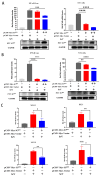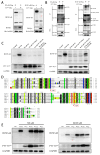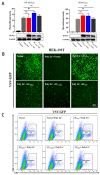Porcine Teschovirus 2 3Cpro Evades Host Antiviral Innate Immunity by Inhibiting the IFN-β Signaling Pathway
- PMID: 40572097
- PMCID: PMC12195036
- DOI: 10.3390/microorganisms13061209
Porcine Teschovirus 2 3Cpro Evades Host Antiviral Innate Immunity by Inhibiting the IFN-β Signaling Pathway
Abstract
Porcine teschovirus (PTV) circulates in pig populations, causing clinical diseases such as poliomyelitis, reproductive disorders, and pneumonia. However, the molecular mechanisms underlying the pathogenesis of PTV infection have not been fully elucidated. Here, we found that PTV infection does not activate the promoters of NF-κB or IFN-β. The expression of PTV 3Cpro inhibits the promoter activity of NF-κB and IFN-β stimulated by SeV and inhibits the downstream transcription of NF-κB and IFN-β by blocking the phosphorylation and nuclear translocation of NF-κB. Coimmunoprecipiation (co-IP) experiments demonstrated that 3Cpro and NF-κB interact. The degradation of NF-κB was unaffected by inhibitors targeting lysosomes (NH4Cl), proteasomes (MG132), or caspases (Z-VAD-FMK). The protease activity of 3Cpro, which relies on its catalytic active site, is vital for NF-κB cleavage and degradation. Loss of proteolytic activity in mutants abolished NF-κB degradation, impairing the ability of 3Cpro to suppress SeV-induced innate immunity and restore VSV-GFP replication, thereby underscoring its critical role in immune evasion by targeting NF-κB. This study reveals novel mechanisms underlying PTV-mediated suppression of host innate immunity.
Keywords: 3Cpro; NF-κB; inhibitor; porcine teschovirus; protease activity.
Conflict of interest statement
The authors declare no conflict of interest.
Figures





Similar articles
-
A MicroRNA Screen Identifies the Wnt Signaling Pathway as a Regulator of the Interferon Response during Flavivirus Infection.J Virol. 2017 Mar 29;91(8):e02388-16. doi: 10.1128/JVI.02388-16. Print 2017 Apr 15. J Virol. 2017. PMID: 28148804 Free PMC article.
-
Viral protease cleavage of MAVS in genetically modified mice with hepatitis A virus infection.J Hepatol. 2023 Feb;78(2):271-280. doi: 10.1016/j.jhep.2022.09.013. Epub 2022 Sep 22. J Hepatol. 2023. PMID: 36152761 Free PMC article.
-
Cullin 3-mediated ubiquitination restricts enterovirus D68 replication and is counteracted by viral protease 3C.J Virol. 2025 Jun 17;99(6):e0035425. doi: 10.1128/jvi.00354-25. Epub 2025 May 21. J Virol. 2025. PMID: 40396757 Free PMC article.
-
Signs and symptoms to determine if a patient presenting in primary care or hospital outpatient settings has COVID-19.Cochrane Database Syst Rev. 2022 May 20;5(5):CD013665. doi: 10.1002/14651858.CD013665.pub3. Cochrane Database Syst Rev. 2022. PMID: 35593186 Free PMC article.
-
The strategies and mechanisms of enteroviruses to evade innate immunity and the vaccine progress of enteroviruses.Front Cell Infect Microbiol. 2025 Jul 31;15:1636104. doi: 10.3389/fcimb.2025.1636104. eCollection 2025. Front Cell Infect Microbiol. 2025. PMID: 40822588 Free PMC article. Review.
References
-
- Trefny L. Massive illness of swine in Teschen area. Zveroleki Obz. 1930;23:235–236.
Grants and funding
LinkOut - more resources
Full Text Sources

